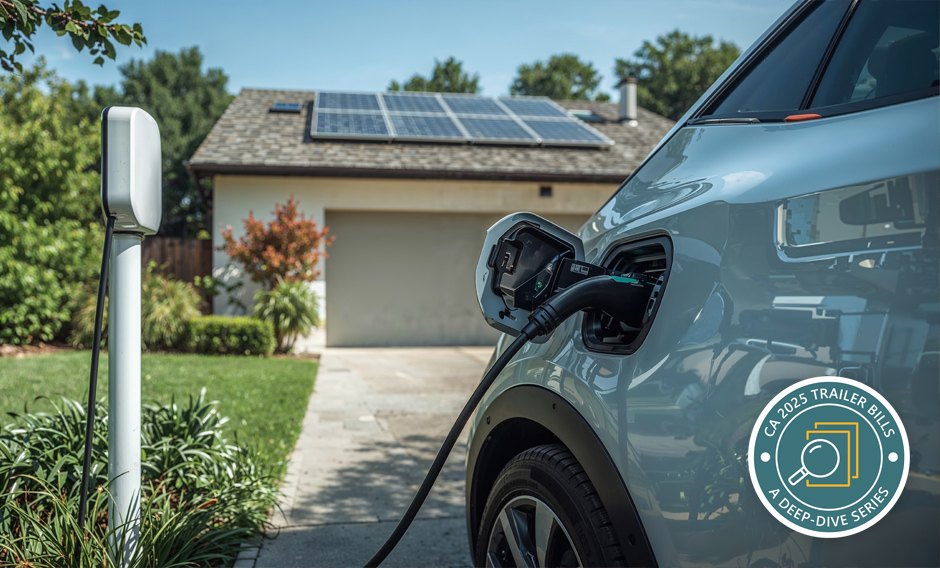Ideas in Response from the 2025 CCEC Forum
The adoption of the California state budget on June 30 was accompanied by a trailer bill package that included some surprises in the enactment of Assembly Bill (AB) 130 and Senate Bill 131. While much of the discussion regarding the trailer bills has been focused on a substantial California Environmental Quality Act (CEQA) pivot, an eye-opener for climate action came with AB 130, which incorporated the previously introduced AB 306 and its moratorium on residential reach codes until 2031. This bill has fundamentally altered the regulatory environment for reach codes for the next six years.
Shortly after AB 130’s enactment, the 16th Annual California Climate and Energy Collaborative (CCEC) Forum brought together local leaders, state agencies, and climate professionals to chart a path forward for climate action, recognizing recent changes, like AB 130. Under the theme “Hope in Action: Local Leads the Way,” the conference emphasized that while challenges persist, local jurisdictions have the power—and the responsibility—to drive meaningful climate progress. Here are key insights that Ascent’s Climate team took away from the conference. Our insights are provided from the practical viewpoint of experienced climate action planners, but they do not constitute legal advice. For legal advice about your community or project, please consult an attorney.
The Building Code Elephant in the Room –
No New Residential Reach Codes?
The enactment of AB 130 incorporated previously introduced AB 306 and its moratorium on residential reach codes until 2031. This bill has fundamentally altered the regulatory environment for local residential building energy reach codes for the next six years. Conference participants self-organized an information session, which acknowledged that while there are still many unanswered questions about the impacts of this legislation, building a shared knowledge base about its implications is critical for maintaining local authority in building decarbonization efforts.
In summary, the legislation mandates a moratorium from October 1, 2025, to June 1, 2031, on “changes or modifications in the requirements contained in the provisions published in the California Building Standards Code,” including to green building standards, that are applicable to residential units, with some limited exceptions (see below). This provision applies the moratorium to the adoption of new local reach codes for residential development for six years and effectively eliminates the 2028 residential Energy Code update cycle. Reach codes are defined as amendments to the Energy Code (Part 6) of the California Building Standards (Title 24), which can include the voluntary energy performance requirements detailed in CALGreen (Part 11 of Title 24). Based on current understanding, the 2025 Energy Code will proceed as planned with an effective date of January 1, 2026, and the 2031 Energy Code cycle is anticipated to be unaffected. Nonresidential building reach codes remain a feasible policy option for local building decarbonization. Intervening code cycle provisions for residential buildings are expected to be limited to minor revisions. However, and importantly, there are several key exceptions that still provide pathways for jurisdictions to continue adopting residential reach codes over the next six years.
Understanding the Exceptions
Sections 29, 30, and 31 of the legislation list six exceptions to the moratorium on residential reach codes, two of which jurisdictions can leverage, though significant questions related to the interpretation of these exceptions remain. First (exception 1), jurisdictions can adopt new amendments that are “substantially equivalent” to existing reach codes, provided they are effective by September 30, 2025. Second (exception 5), jurisdictions may have another pathway to adopt new residential reach codes per general plan and adopted greenhouse gas (GHG) emissions reduction strategy alignment.
Related to exception 5, subject matter experts believe that jurisdictions have latitude to interpret this exception, but they should consult legal counsel to make any determinations. Importantly, the legislation does not define “adopted GHG emissions reduction strategy,” though it is presumed to be one that meets State CEQA Guidelines Section 15183.5(b).
Pathways Forward
For jurisdictions with adopted residential reach codes (based on the 2022 Energy Code, inclusive of CALGreen energy performance requirements), the path may be more straightforward. They can potentially extend their current reach codes past January 1, 2026, without changes using the substantially equivalent exception (exception 1). Adopted reach codes must be in effect as of September 30, 2025, to use this exception.
For jurisdictions without adopted residential reach codes, three primary pathways have emerged:
- Option A: Adopt a reach code that amends the 2022 Energy Code with an effective date prior to September 30, 2025. This approach is necessary because the 2025 Energy Code is not in effect yet and therefore cannot be “amended.” When the jurisdiction adopts the 2025 California Building Standards, it may use exception 1 to adopt a reach code to the Energy Code (Part 6) that the relevant local decision-making body finds “substantially equivalent.”
- Option B: Adopt the entire 2025 California Building Standards and energy reach codes before September 30, 2025. This option represents a major work effort requiring building departments to evaluate every section of the code.
- Option C: Adopt only the Energy Code (Part 6) of the 2025 California Building Standards and energy reach codes before September 30, 2025, with the remainder adopted later. This option provides a middle ground for building departments that cannot evaluate the entire code in the available time frame.
Importantly, nonresidential reach codes are still a viable policy option that jurisdictions have to advance building electrification and support widespread EV adoption. The legislation does not put a moratorium on nonresidential reach codes for the 2025 or 2028 code cycles.
Ongoing Uncertainties and Support Resources
Significant uncertainty remains around key provisions and exceptions of AB 130. The California Energy Commission (CEC) and California State Building Commission are determining what guidance they will provide, though no timeline has been established. Questions persist about the specific requirements for qualified GHG reduction plans and their relationship to the State CEQA Guidelines.
To support jurisdictions navigating these complexities, several resources are being developed. Model ordinance language is being made available through the Local Energy Codes and Bay Area Reach Codes websites and by community choice energy providers like Clean Power Alliance and Central Coast Community Energy.
Conference attendees and subject matter experts emphasized that while these regulatory changes create challenges, they also underscore the importance of collaborative action and shared resources. Jurisdictions that act quickly, engage with legal counsel, and leverage available support resources can maintain their authority to drive building decarbonization efforts despite the compressed timeline and regulatory uncertainties. We recommend reviewing BayREN’s outline of the legislation’s provisions and reach code pathway options to learn more.
If your jurisdiction is intending to develop a reach code, it is recommended that you contact the CEC for guidance at vog.ac.ygrene@secnanidrolacol.
The Imperative to Be Nimble
The conference underscored a critical lesson from recent history: Preparation for climate action is everything. Some jurisdictions missed opportunities to secure grants from previous federal administrations simply because they weren’t ready when funding became available. The Infrastructure Investment and Jobs Act and the Inflation Reduction Act represented unprecedented opportunities, but only for those who moved quickly.
To anticipate future funding windows, state and local agencies should maintain project pipelines with shovel-ready initiatives that can be rapidly deployed. This requires ongoing planning and project development, even when specific funding sources aren’t yet identified. The message was clear: Don’t wait for the money to start planning.
The Power of Collaboration across All Government Levels
Perhaps no theme resonated more strongly than the need for enhanced collaboration and capacity building across all levels of government. The climate challenge is too complex and resource-intensive for any single jurisdiction to tackle alone, particularly in rural areas where capacity constraints are most acute.
The conference highlighted successful models of resource sharing and joint grant applications that allow smaller jurisdictions to access funding that would otherwise be out of reach. Working with community-based organizations (CBOs) emerged as particularly crucial, with speakers emphasizing the need to earmark funding specifically for relationship building and outreach efforts.
Building these partnerships requires up-front investment in time and resources, but the payoff extends beyond individual projects. Strong collaborative relationships become valuable assets in grant applications, demonstrating to funders that projects have broad support and sustainable implementation capacity.
The Need for Creative Solutions
With traditional funding sources facing constraints, creative financing emerged as a critical necessity. The conference addressed the detrimental effects of boom-and-bust funding cycles on climate progress, emphasizing the urgent need for more consistent, stable, and predictable funding sources.
Cap-and-trade revenues and state climate bonds, while valuable, cannot fund the entire economic transition required. With limited federal support, local governments face the prospect of shouldering disaster recovery costs that could strain available resources. This reality demands innovative approaches to climate finance.
Participants explored promising alternatives including climate mitigation parcel taxes (e.g., San Francisco’s parcel tax to restore tidal marshes around the Bay to mitigate flooding from sea level rise and climate-related storms), community benefit agreements, and endowment funds. The Humboldt Offshore Wind Community Benefits Agreement was highlighted as a successful model for securing long-term commitments from private developers.
The conference also addressed critical data gaps that hinder effective climate action. The CPUC’s 15/15 rule prevents universal access to building energy data, limiting local agencies’ ability to target decarbonization efforts effectively. However, numerous tools and dashboards are available to help jurisdictions understand where to focus their efforts, including the Cost Effectiveness Explorer, BayREN Energy Atlas, UCLA Energy Atlas, AB 802 Building Energy Benchmarking, and BayREN’s Existing Buildings Study.
Speakers emphasized the importance of addressing intersectional climate issues, particularly the connection between wildfire risk reduction and electric safety planning. Innovative programs like Match.Graze, which connects livestock producers and landowners to expand prescribed grazing for carbon sequestration and wildfire risk reduction, demonstrate how creative partnerships can address multiple challenges simultaneously.
Celebrating Progress and Building Momentum
Despite the challenges, the conference concluded on a note of celebration and optimism. The passage of Proposition 4, the 2024 climate bond, represents a significant vote of confidence from California voters. Advances in carbon-free grid management, including impressive battery storage installations and grid management capabilities demonstrated in June, show that the clean energy transition is accelerating.
The launch of effective implementation and monitoring tools like ICLEI USA’s ClearPath 2.0 provides jurisdictions with better resources to track progress and demonstrate impact. The Elk Grove Climate Compass dashboard exemplifies how these tools can make climate data accessible and actionable for local decision-makers.
The 2025 CCEC Forum reinforced that hope in climate action isn’t passive optimism—it’s an active commitment to preparation, collaboration, creativity, and celebration of progress. Local governments have the tools, resources, and increasingly, the mandate to lead on climate action.
If you have questions about the AB 130 moratorium, including options useful for your community, please feel free to contact Ascent’s co-authors: Hannah Kornfeld, AICP, Climate Practice Leader; Claire Moss, Climate Project Manager; or Erik de Kok, AICP, Director of Interdisciplinary Planning.



